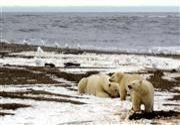Toxins Foul Arctic Ocean Food Chains, Threaten Polar Bears

Polar bears are ailing as industrial pollutants move north to the Arctic from industrialized zones via air and sea currents, Danish researchers say.
The toxins primarily absorbed by the ocean food chain infect polar bears as they are the peak predators in the Arctic Ocean food chain.
The study from the University of Copenhagen and the Aarhus University suggests industrial chemicals such as mercury and organochlorines seem to affect the bears worst. The study, published in the journal Environment International reviewed that these chemicals have a range of subclinical effects.
Being fat soluble, these chemicals tend to accumulate in the fat of many animals, which are then eaten by top predators such as polar bears.
These include toxic metals such as mercury, organohalogen contaminants, including organochlorines and polybrominated diphenyl ethers and perflourinated compounds, which are used industrially in insulating fluids as coolants, in foams and electronics and as pest control agents.
The first ever meta-study conducted from 2000 through 2010 addressed the effects of contaminants on the health of animal species in the Arctic region.
Lead researcher Christian Sonne, senior scientist at Aarhus University, along with researchers from its Faculty of Life Sciences, analysed results of more than 200 organ, skull tissue and bone samples from about 100 east Greenlandic polar bears as well as repeated measurements and observations of bears living in the Svalbard archipelago, Norway, to understand the impact of these toxins on the Arctic food chain.
The accumulated industrial chemicals cause diseases in the polar bears which do not lead to their immediate deaths. On the other hand, the toxins damage the bones and organs of the polar bears, their immune systems and not least their reproductive systems. However, the harm suffered by the population of polar bears in eastern Greenland is not yet fully understood, said Sonne.
Sonne concludes that climatic change would worsen the impact of pollutants on the bears.
A reason could be that as the level of sea ice declines with warming temperatures, polar bears tend to fast for prolonged periods. This may mean they eat fewer seals and therefore less pollutants overall. But they will have to burn fat to compensate. That will release greater concentrations of toxins from their fat stores into their blood, explained Sonne.
This might cause further illness, weakening the bears that already live in poorer conditions and are liable to be exposed to new and more virulent pathogens capable of surviving in a warmer Arctic.
According to the researchers, the impact of these toxins on polar bears has been difficult to measure, partly because of logistics that make it impossible to take repeated samples of blood or tissue from live polar bears.
Also, because only free-ranging healthy animals that are not clinically sick tend to be sampled, it usually implies that the overall sample population appears to be healthier than it already is.
These studies reveal a number of ill effects associated with industrial pollutants. However, such studies can only show that contaminant levels are correlated with ill effects, not that they cause them. Polar bear studies are correlative, but that is not conclusive as being 'cause and effect', explained Sonne.
© Copyright IBTimes 2025. All rights reserved.





















